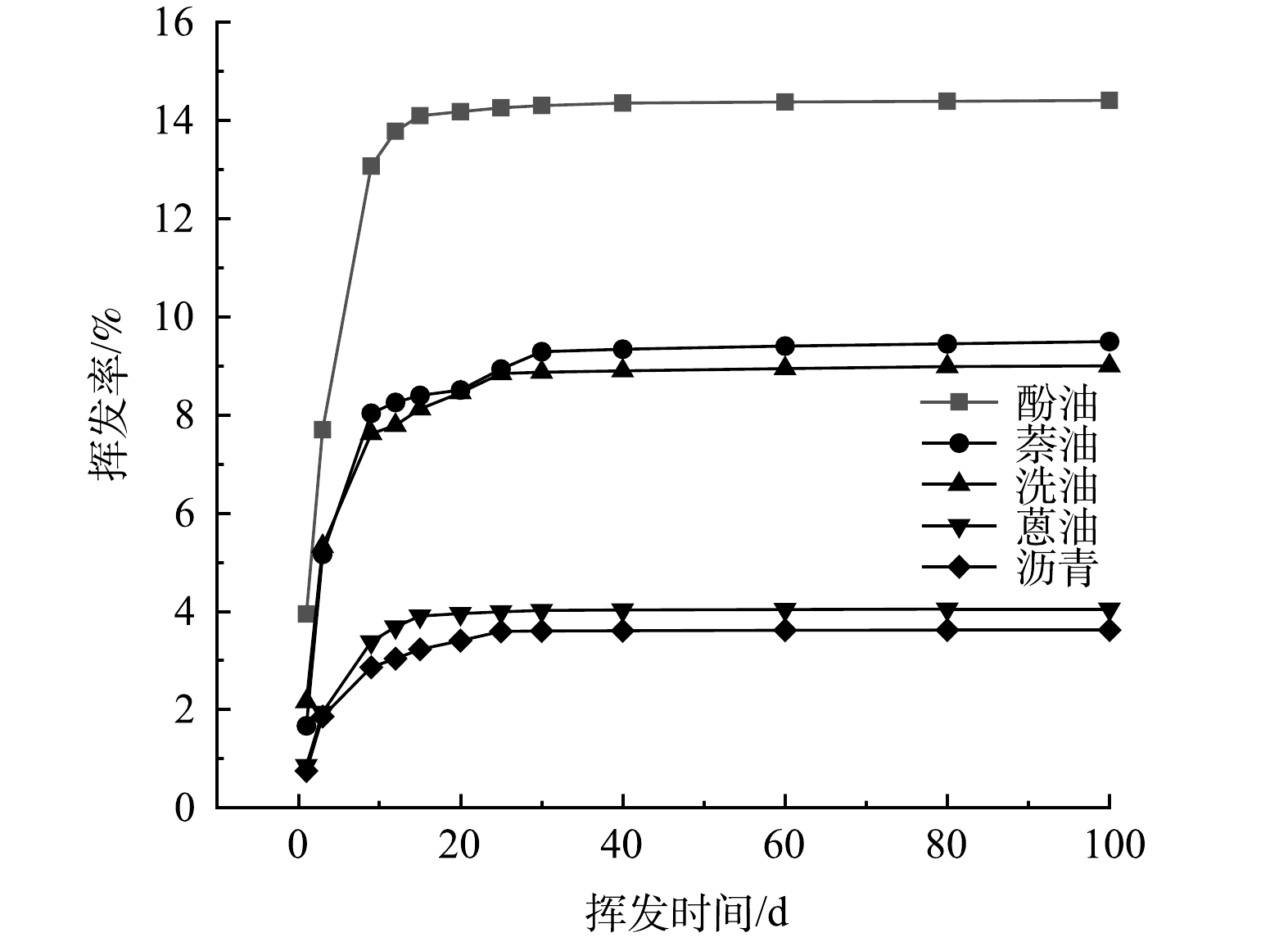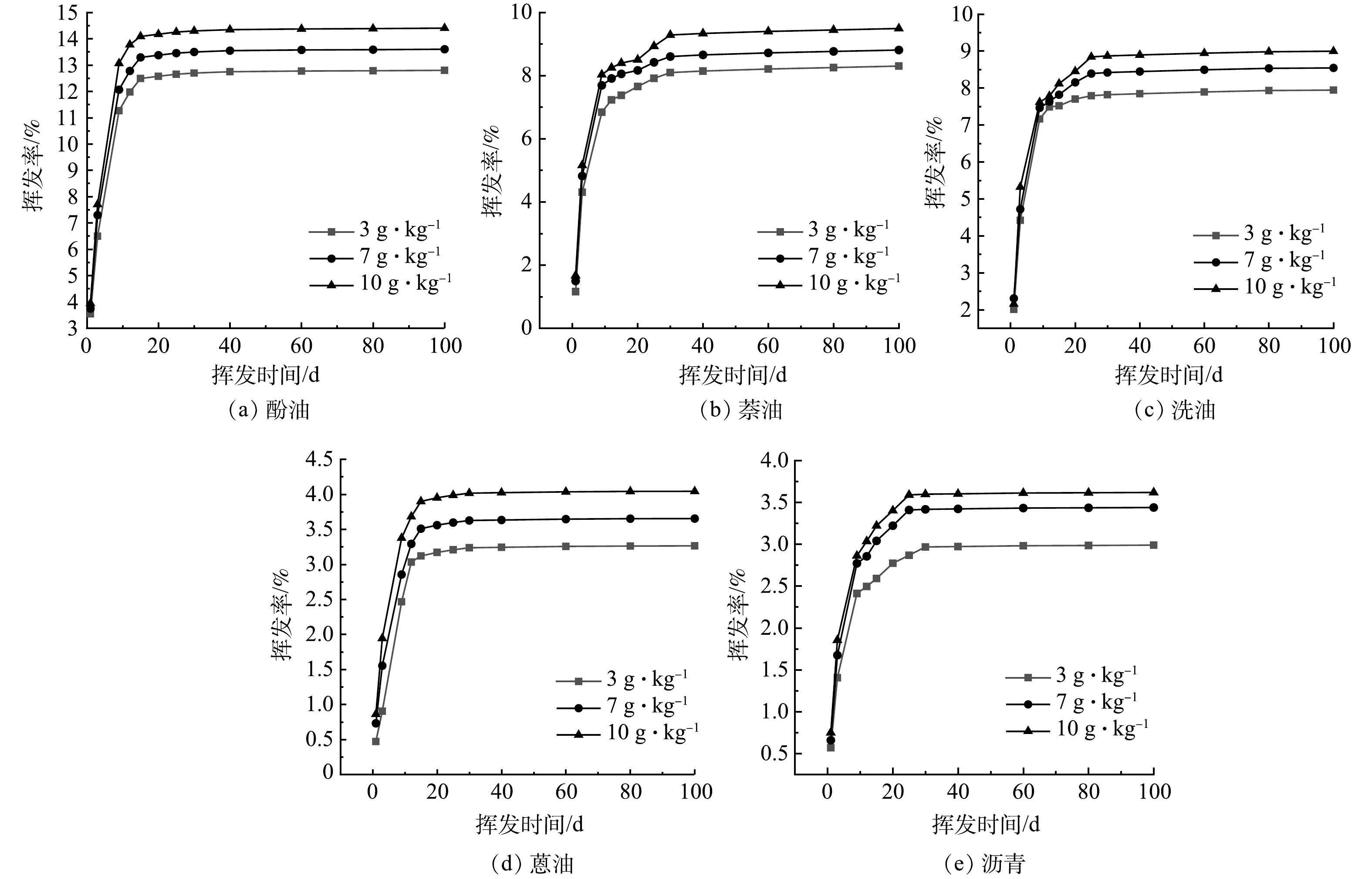-
我国是煤炭消费大国,煤炭消费占能源总消费的56.8%。其中80%的煤炭直接作为燃料燃烧,资源利用率低,并对环境造成一系列污染[1]。由于我国“贫油、少气、相对富煤”的能源结构特点,发展洁净煤技术对实现煤炭清洁高效利用、提高经济效益和改善环境问题具有重要意义[2]。富油煤是集煤、油、气属性于一体的矿产资源。在煤田地质学中,将低温焦油产率大于7%、小于等于12%的煤称为富油煤[3]。由于富油煤具有较高的含氢量,可获得高收率油、气、半焦产品,用来弥补缺油、少气及焦煤稀少等问题。陕西富油煤储量丰富,高达1 500×108 t,排全国第1位[2]。目前,我国对富油煤的利用方式多为直接燃烧,尚未将其有效价值达到高效利用[4]。富油煤低温热解作为煤炭高效清洁转化的一种方式,具有热解工艺条件相对温和、生产成本低、煤种适应范围广等特点[5],是煤炭资源高效清洁利用的必经阶段。煤焦油作为富油煤热解的主要产物,是一种黑色或褐黑色粘稠状,以芳香烃为主的有机混合物,具有特殊气味,易挥发。富油煤热解焦油按照其馏分沸点的不同可以分为轻油、酚油、萘油、洗油、蒽油和沥青6种组分[6]。这些组分可通过富油煤原位热解过程形成的压裂缝进入地下岩层从而产生一系列环境行为。
污染物的环境行为主要有对流、弥散、吸附、降解和挥发等。当其进入地下环境后,在水分的驱动下产生对流和弥散作用,使溶解在水中的污染物发生迁移[7-8];在迁移过程中污染物会随着地下水位的波动发生部分吸附,但吸附过程只是转移却并不能彻底去除污染物[9-11];降解则是在光照、植物以及微生物等作用下进一步将有机污染物分解为小分子物质,从而减少其在环境中的含量,是决定有机污染物在地下环境迁移的重要因素[11-15]。挥发性污染物会随空气流动产生挥发作用,其影响因素有温度、风速、土壤固有性质、构成等。挥发可影响污染物在其他环境中的归属[16-19]。陕西省榆神府矿区处于黄河中游,属毛素乌沙漠和黄土高原接壤地带。粉砂作为该地区的典型岩性,广泛地分布于地表以及含水介质中[20]。本研究以榆神府矿区典型岩性粉砂为实验土壤,针对煤焦油中各种组分开展其在粉砂中的自然降解与挥发行为研究,查明煤焦油各组分在粉砂中的自然降解和挥发规律,以期为开展原位开采引起的地下环境污染控制与修复提供参考。
-
实验所用土壤采自陕西省榆神府矿区典型含水介质-粉砂。土样去除石块、败叶等杂物,自然风干过筛后备用。其基本物理化学性质如表1所示。
实验所用煤焦油以张家峁矿区4−2煤层富油煤为原料,经自然干燥、粉碎后,在低温热解装置中于550 ℃热解2 h后制得。经气相色谱仪检测分析,煤焦油成分组成如表2所示。其中,由于轻油占比过少,故本次富油煤热解焦油选取其中5种主要组分。
-
仪器。气相色谱仪 (GC1100,北京普析通用仪器有限公司) ;超纯水器 (UPL-I-40L,四川优普超纯水科技有限公司) ;台式离心机 (TGL-15B,上海安亭科学仪器厂) ;电热鼓风干燥箱 (101-3AB,天津市泰斯仪器有限公司) ;旋转蒸发仪 (RE-300,上海亚荣生化仪器厂) 。
试剂。丙酮 (分析纯)
-
1) 自然降解实验。准确称取3份100 g土壤样品置于烧杯中,分别将0.3、0.7、1 g煤焦油均匀加入土样中配制质量浓度为3、7、10 g·kg−1的污染土壤,用保鲜膜封口并避光置于15、25、35 ℃的温度环境中,分别于0、3、9、12、15、20、25、30、40、60、80、100 d取样。采集样品在8 000 r·min−1条件下离心10 min,取0.2 μL上清液注入气相色谱仪测定煤焦油质量浓度。
2) 挥发实验。准确称取3份100 g土壤样品在200 ℃下煅烧2 h后置于烧杯中,分别将0.3、0.7、1.0 g煤焦油均匀加入土样中配制质量浓度为3、7、10 g·kg−1的污染土壤,避光置于15、25、35 ℃的温度环境中,分别于0、3、9、12、15、20、25、30、40、60、80、100 d取样测定煤焦油质量浓度。测定方法同上。
3) 组分测定。采用气相色谱仪 (GC1100) 对煤焦油组分进行检测分析。煤焦油的检测主要模拟通过蒸馏方法分析焦油中各馏分分布,其原理是具有一定分离程度的非极性色谱柱,在线性程序升温条件下测试已知混合物组分的保留时间[5]。然后在相同的色谱条件下,将试样按组分沸点依次分离如表3所示,同时进行切片积分,获得对应的累积面积,以及相应的保留时间。实验时载气选用高纯氮气 (N2,99.999%) ,气体流速为5 mL·min−1,氢气流速为35 mL·min−1,进样口温度为300 ℃,柱箱温度为初温40 ℃,以9 ℃·min−1升温至300 ℃,起始温度t0停留2 min,终温tf停留3 min,采集时间为1 h。
-
1) 自然降解动力学方程。将自然降解的实验数据分别采用一级动力学、二级动力学进行拟合。一级动力学方程如式(1)所示[21]。
式中:Ct、C0为土壤中污染物t时刻的质量浓度与初始质量浓度,mg·g−1;t为时间,h;k为反应速率常数。半衰期的计算公式如式(2)所示。
二级动力学方程如式(3)所示。
式中:Ct、C0为土壤中污染物t时刻的质量浓度与初始质量浓度,mg·g−1;t为时间,h;k为反应速率常数。半衰期计算公式如式(4)所示。
2) 挥发动力学方程
将煤焦油中的5种组分在粉砂中的挥发动力学过程分别采用Elovich、抛物线、零级动力学方程进行拟合。Elovich动力学方程如式(5)[22-24]所示。
式中:m为t时刻组分的挥发量,mg;A为常数;B为挥发速率常数。
抛物线动力学方程如式(6)所示。
式中:t为挥发时间,h;a为常数,为更好地比较多孔介质中石油挥发速率系数变化,将a取为0;k为挥发速率系数,g·h−0.5。
零级动力学方程如式(7)所示。
式中:m为t时刻多孔介质中组分的挥发量,g;t为挥发时间,h;k为污染物挥发速率的零级动力学常数,g·h−1;a为常数。
-
1) 降解动力学特征。25 ℃时粉砂中煤焦油各组分的降解动力学曲线如图1所示。由图可知,粉砂中煤焦油各组分的降解动力学特征大体相同,均可分为3个阶段。①快速降解阶段 (0~10 d) ,此阶段污染物质量浓度较大,微生物碳源丰富,生长迅速,因此降解速率快,污染物质量浓度快速降低。②缓慢降解阶段,酚油和蒽油 (10~15 d) ,洗油和沥青 (10~25 d) ,萘油 (10~30 d) ,由于微生物经过上一阶段快速生长后逐渐达到稳定,细胞代谢活力逐渐变缓。③降解平衡阶段,酚油和蒽油 (15~100 d) ,洗油和沥青 (25~100 d) ,萘油 (30~100 d) 。经历前面2个阶段后,污染物质量浓度逐渐减少,微生物含量有限,因此该阶段降解速率逐渐平缓。由该降解动力学过程可知,在相同条件下微生物对不同种类的煤焦油组分降解能力是不同的[15,25],因此煤焦油各组分在粉砂中的降解率顺序为,酚油>洗油>萘油>沥青>蒽油。其中酚油的降解率最高为64.0%,蒽油的降解率最低为25.1%。
分别用一级动力学反应方程和二级动力学反应方程对数据进行拟合,拟合结果如表4所示。由表4可知,煤焦油在粉砂中的降解更符合一级动力学方程,相关性系数在0.903 8~0.934 4之间,降解半衰期在112~228 d之间。其中降解速率常数反映了煤焦油各组分降解快慢。因此,酚油降解最快,其降解速率常数最大,为6.18×10−3。而蒽油的半衰期最长,为228 d。这表明,煤焦油中5种组分在粉砂中较为稳定,不易被降解转化。
2) 影响因素。首先,温度影响。温度作为重要的环境因素,会直接影响微生物的酶活性、生长代谢以及群落结构。图2显示了温度变化对煤焦油各组分降解率的影响。由图2可知,温度越高,降解率越大。由于在低温条件下酶活性降低会抑制微生物的生长发育[26]。因此,当温度为35 ℃时,煤焦油各组分的降解率均达到最大值,酚油为67%,蒽油为31.19%。而15 ℃时,降解率均为最小值,酚油为53.97%,蒽油为21.01%。
其次,污染物初始质量浓度的影响。在相同的环境条件下,煤焦油的初始质量浓度水平对其降解率有着直接的影响。图3为不同污染物初始质量浓度下煤焦油各组分降解率变化情况。从图3可以看出,污染物初始质量浓度越高,降解率越大,降解效果越好。可利用性是控制疏水性有机物降解的主要因素[12],由于低浓度会降低有机物的生物可利用性,不利于煤焦油各组分在粉砂中的降解[15]。因此,当质量浓度为10 g·kg−1时,煤焦油各组分的降解率均达到最大值,酚油为72%,蒽油为35.10%;3 g·kg−1时,降解率均为最小值,酚油为63.99%,蒽油为25.34%。
-
1) 挥发动力学特征。25 ℃时粉砂中煤焦油各组分的挥发动力学曲线如图4所示。由图可知,粉砂中煤焦油各组分挥发率均呈现随挥发时间的增加挥发率逐渐缓慢上升,最终趋于平衡的特征,其过程可分为3个阶段。①快速挥发阶段,酚油、萘油和蒽油 (0~12 d),洗油和沥青 (0~9 d)。该阶段污染物质量浓度较高,挥发较快。②慢速挥发阶段,酚油 (12~25 d),萘油 (12~30 d),蒽油 (12~20 d),洗油和沥青 (9~25 d),由于第一阶段挥发了大量污染物,剩余污染物部分被粉砂吸附固结在粉砂上,因此挥发速率减慢。③挥发平衡阶段,酚油 (25~100 d),萘油 (30~100 d),蒽油 (20~100 d),洗油和沥青 (25~100 d)。由于重质组分的可挥发性差,而轻质组分以液相和气相存在易挥发,导致挥发率差异明显。因此煤焦油各组分挥发率顺序为,酚油>萘油>洗油>蒽油>沥青。其中酚油挥发率为14.4%,沥青挥发率为3.6%。
分别用Elovich动力学方程、抛物线动力学方程和零级动力学方程对数据进行拟合,拟合结果如表5所示。由表5可知,Elovich动力学方程能较好表达煤焦油中的5种组分在粉砂中的挥发量和时间的关系[11]。方程中常数A为第1 h煤焦油各组分的挥发量,酚油和沥青在粉砂中挥发时的A值差异较为明显,这说明在初始挥发的1 h,酚油在粉砂中挥发较快。
2) 影响因素。首先,温度的影响。粉砂中煤焦油组分在不同温度下挥发率随时间的变化关系如图5所示。由图5可知,温度越高,挥发率越大。具体表现为,当温度为35 ℃时,煤焦油各组分的挥发率最大,酚油为13.40%,沥青为3.45%;15 ℃时,挥发率均为最小值,酚油为10.79%,沥青为2.52%。这是由于煤焦油各组分的动能随温度的升高而提高,令更多的分子具有快速穿过滞留空气边界层进入大气的能力,而低温不利于煤焦油各组分的扩散[27]。
其次,污染物初始质量浓度的影响。25 ℃时粉砂中煤焦油各组分在不同污染物初始质量浓度下挥发率随时间的变化关系如图6所示。由图可知,不同污染质量浓度煤焦油各组分的挥发率均随着时间呈现先上升后趋于平衡的特征。当污染物初始质量浓度从3 g·kg−1增加到10 g·kg−1时,酚油的增幅最大为1.61%,沥青增幅最小为0.63%,污染物初始质量浓度对煤焦油各组分的挥发产生的影响较小。
-
1) 煤焦油各组分在粉砂中的自然降解符合一级反应动力学方程,降解率顺序为,酚油>洗油>萘油>沥青>蒽油。其中,酚油的降解速率常数最大,为6.18
$ \times $ 10−3;而蒽油的半衰期最长,达到了228 d;随着温度和污染物初始质量浓度的增加,煤焦油组分在粉砂中的降解率不断增大。其中酚油在温度为25 ℃,质量浓度为10 g·kg−1的条件下,降解效果最好,降解率为72%。2) 煤焦油各组分在粉砂中的挥发符合Elovich动力学方程,在初始1 h中,酚油挥发最快,沥青最慢。各组分在粉砂中的挥发率顺序为,酚油>萘油>洗油>蒽油>沥青。其中,酚油的挥发率是沥青的4倍;酚油在35 ℃时的挥发率是15 ℃的1.2~2.5倍,污染物初始质量浓度对煤焦油各组分的挥发影响较小。
富油煤热解焦油在粉砂中的自然降解与挥发行为
Natural degradation and volatilization of oil-rich coal pyrolysis tar in siltly sand
-
摘要: 富油煤原位热解的油、气等产物可通过开采形成的压裂缝进入地下环境,产生一系列环境行为。为进一步了解富油煤热解产物在地下环境中的自然降解与挥发行为,选择粉砂作为典型土壤,以富油煤热解焦油为典型污染物,开展了煤焦油5种组分在粉砂中的自然降解和挥发行为研究,建立了2种环境行为的动力学模型;进一步考察了温度、污染物初始质量浓度等因素对自然降解与挥发的影响。结果表明,煤焦油各组分在粉砂中的降解效果顺序为,酚油>洗油>萘油>沥青>蒽油,且粉砂中各组分的自然降解符合一级动力学方程。其中,酚油的降解速率常数最大,为6.18×10−3;而蒽油的半衰期最长,达到了228 d;温度35 ℃时的降解率为67%,初始质量浓度为10 g·kg−1时,降解率高达72%。粉砂中煤焦油的挥发符合Elovich方程,各组分在粉砂中的挥发效果顺序为,酚油>萘油>洗油>蒽油>沥青。其中,酚油的挥发率是沥青挥发率的4倍;酚油在35 ℃时的挥发率是15 ℃的1.2~2.5倍,污染物初始质量浓度对煤焦油各组分的挥发影响较小。本研究结果可为开展原位开采引起的地下水环境污染控制与修复提供参考。Abstract: The oil, gas, and other products of in-situ pyrolysis of oil-rich coal can enter the underground environment through fracturing fractures formed by mining, resulting in a series of environmental behaviors. To further understand the natural degradation and volatilization of oil-rich coal pyrolysis products in the underground environment, silt was selected as a typical soil, and tar from oil-rich coal pyrolysis was taken as a typical pollutant. The natural degradation and volatilization behaviors of five components of coal tar in silt were studied, the kinetic models of the two environmental behaviors were established, and the effects of temperature, initial concentration of pollutants and other factors on natural degradation and volatilization were further investigated. The results indicated that: the order of degradation effect of each component of coal tar in silt was phenol oil> washing oil> naphthalene oil> asphalt > anthracene oil; The natural degradation of each component in silt accords with the first-order kinetic model. The degradation rate constant of phenolic oil was 6.18×10−3, and the half-life of anthracene oil was 228 d. When the temperature was 35 ℃, the degradation rate was 67%. And it was increased to 72% when the initial concentration of pollutants was 10 g·kg−1. The volatilization of coal tar in silt fitted with the Elovich equation, the volatilization rate of each component in silt was phenol oil> naphthalene oil> washing oil> anthracene oil> asphalt, in which the volatilization rate of phenol oil was four times than that of asphalt. The volatilization rate at 35 ℃ was 1.2~2.5 times that at 15 ℃, and the initial concentration of pollutants had no significant effect on the volatilization of coal tar components. The results of this study can provide reference for the control and remediation of groundwater environmental pollution caused by in-situ mining.
-
Key words:
- oil-rich coal pyrolysis tar /
- siltly sand /
- natural degradation /
- volatilization /
- influencing factors
-

-
表 1 土壤基本物理化学性质
Table 1. Basic parameters of soils samples
粒径/mm 干容重/(g·cm−3) 含水量/(cm3·cm−3) 有机质质量分数/% 主要化合物质量占比/% SiO2 CaCO3 Al2O3 MgO FeO 0.07~0.25 1.48 0.23 0.94 63.00 28.72 5.33 1.80 1.15 表 2 焦油成分组成
Table 2. The composition of tar
成分 质量浓度/(g·L−1) 占比/% 成分 质量浓度/(g·L−1) 占比/% 轻油 0.001 0.08 洗油 0.703 14.07 酚油 0.102 3.04 蒽油 0.825 16.50 萘油 0.263 6.27 沥青 3.105 60.05 表 3 煤焦油馏分与沸点对应关系
Table 3. Boiling points range for classifying tar fractions
°C 轻油 酚油 萘油 洗油 蒽油 沥青 <170 170~210 210~230 230~300 300~360 >360 表 4 煤焦油在粉砂介质中的降解动力学模型
Table 4. Degradation kinetics model of coal tar in silty sand medium
污染物 一级反应方程 二级反应方程 k R2 半衰期 k R2 半衰期 酚油 6.18×10−3 0.903 8 112 0.233 7 0.241 3 58 萘油 3.74×10−3 0.934 4 185 0.972 3 0.124 6 26 洗油 5.19×10−3 0.917 0 133 0.041 1 0.175 4 47 蒽油 3.04×10−3 0.913 8 228 0.006 3 0.247 1 309 沥青 3.16×10−3 0.926 6 219 0.026 5 0.198 2 20 表 5 煤焦油组分在粉砂介质中的挥发动力学模型
Table 5. Kinetic model of volatilization of coal tar components in silty sand medium
污染物 Elovich 抛物线方程 零级动力学方程 A B R2 a1 k2 R2 a2 k3 R2 酚油 0.043 51 0.011 0 0.920 3 0.005 1 0.000 6 0.547 3 0.006 6 1.74×10−4 0.341 4 萘油 0.021 60 0.006 6 0.951 2 0.001 6 0.000 3 0.586 3 0.002 1 4.30×10−4 0.338 7 洗油 0.019 41 0.004 2 0.913 1 0.022 7 0.002 5 0.530 2 0.028 9 1.82×10−4 0.330 4 蒽油 0.007 45 0.001 5 0.921 0 0.005 1 0.001 6 0.630 3 0.009 1 1.20×10−4 0.415 6 沥青 0.004 59 0.000 6 0.961 7 0.024 4 0.004 3 0.660 6 0.034 6 3.19×10−4 0.444 4 -
[1] 杨英明, 孙建东, 李全生. 我国能源结构优化研究现状及展望[J]. 煤炭工程, 2019, 51(2): 149-153. [2] 王双明, 师庆民, 王生全, 等. 富油煤的油气资源属性与绿色低碳开发[J]. 煤炭学报, 2021, 46(5): 1365-1377. doi: 10.13225/j.cnki.jccs.ST21.0860 [3] 马丽, 拓宝生. 陕西富油煤资源量居全国之首榆林可“再造一个大庆油田”[J]. 陕西煤炭, 2020, 39(1): 220-222. doi: 10.3969/j.issn.1671-749X.2020.01.055 [4] 裴贤丰. 低阶煤中低温热解工艺技术研究进展及展望[J]. 洁净煤技术, 2016, 22(3): 40-44. doi: 10.13226/j.issn.1006-6772.2016.03.009 [5] 张蕾, 韩智坤, 舒浩, 等. 陕北富油煤低温热解提油基础特性[J]. 煤炭工程, 2022, 54(9): 124-128. [6] 田华, 张晴, 谢祖锋, 等. 富油煤热解产物在粉砂介质中的吸附行为研究[J]. 环境科学报, 2022, 42(9): 133-140. [7] 谷广锋, 曹兴涛, 刘铭辉, 等. 滨海地区石化行业地下水污染物迁移转化研究[J]. 中国石油和化工标准与质量, 2022, 42(11): 93-95. doi: 10.3969/j.issn.1673-4076.2022.11.034 [8] 田蕴, 杨雾晨. 重金属在地下水波动带土壤中的迁移规律研究[J]. 环境科学与管理, 2019, 44(10): 40-44. doi: 10.3969/j.issn.1673-1212.2019.10.008 [9] 肖磊, 王海芳. 四环素类抗生素在土壤环境中的残留及环境行为研究进展[J]. 应用化工, 2020, 49(12): 3178-3184. doi: 10.3969/j.issn.1671-3206.2020.12.046 [10] 周震峰, 张海光, 王茜. 生物炭对邻苯二甲酸二甲酯在土壤中自然降解和吸附行为的影响[J]. 环境工程学报, 2014, 8(10): 4474-4479. [11] 申圆圆. 土壤中石油污染物行为特征及植物根际修复研究[D]. 西安: 长安大学, 2012. [12] 张学佳, 纪巍, 康志军, 等. 土壤中石油类污染物的自然降解[J]. 石化技术与应用, 2008(3): 273-278. doi: 10.3969/j.issn.1009-0045.2008.03.019 [13] WANG S, WANG D, YU Z C, et al. Advances in research on petroleum biodegradability in soil[J]. Environmental Science-Processes & Impacts, 2021, 23(1): 9-27. [14] CHEN J X, WANG Y G, WEI Y C, et al. Bioremediation of the petroleum contaminated desert steppe soil with rhodococcus erythropolis KB1 and its effect on the bacterial communities of the soils[J]. Geomicrobiology Journal, 2021, 38(10): 842-849. doi: 10.1080/01490451.2021.1964111 [15] 张丹, 姜林, 夏天翔, 等. 土壤-地下水系统中石油烃的迁移和生物降解述评[J]. 环境工程, 2015, 33(7): 1-6. doi: 10.13205/j.hjgc.201507001 [16] 郎梦凡. 石油烃在不同土壤中的挥发及迁移规律研究[D]. 西安: 西北农林科技大学, 2022. [17] 马艳飞, 郑西来, 冯雪冬, 等. 多孔介质中柴油的挥发行为[J]. 化工学报, 2011, 62(4): 1097-1102. [18] 李玉瑛. 土-水系统石油污染物挥发和生物降解过程研究[D]. 青岛: 中国海洋大学, 2005. [19] 张晶, 林先贵, 刘魏魏, 等. 土壤微生物群落对多环芳烃污染土壤生物修复过程的响应[J]. 环境科学, 2012, 33(8): 2825-2831. doi: 10.13227/j.hjkx.2012.08.006 [20] 苗霖田, 夏玉成, 段中会, 等. 黄河中游榆神府矿区煤-岩-水-环特征及智能一体化技术[J]. 煤炭学报, 2021, 46(5): 1521-1531. doi: 10.13225/j.cnki.jccs.st21.0216 [21] 王威, 苏小四, 张玉玲, 等. 石油类污染场地的自然衰减作用[J]. 吉林大学学报(地球科学版), 2011, 41(S1): 310-314. doi: 10.13278/j.cnki.jjuese.2011.s1.061 [22] 黄廷林, 史红星. 黄土地区石油类挥发试验与挥发动力学[J]. 西安建筑科技大学学报(自然科学版), 2003(2): 111-115. doi: 10.15986/j.1006-7930.2003.02.004 [23] 马艳飞, 郑西来, 冯雪冬, 等. 多孔介质中石油挥发过程研究[J]. 中国海洋大学学报(自然科学版), 2011, 41(9): 53-58. doi: 10.16441/j.cnki.hdxb.2011.09.009 [24] 李玉瑛, 郑西来, 李冰, 等. 柴油挥发行为的研究[J]. 化工环保, 2005(6): 423-426. doi: 10.3969/j.issn.1006-1878.2005.06.002 [25] YANG Y, ZHANG N, XUE M, et al. Effects of soil organic matter on the development of the microbial polycyclic aromatic hydrocarbons (PAHs) degradation potentials[J]. Environmental Pollution, 2011, 159(2): 591-595. doi: 10.1016/j.envpol.2010.10.003 [26] 申圆圆, 王文科, 李菁, 等. 土壤中石油烃微生物降解动力学[J]. 油气田环境保护, 2017, 27(4): 11-14. doi: 10.3969/j.issn.1005-3158.2017.04.003 [27] 李永霞. 含水介质中石油污染物迁移与残留特征[D]. 青岛: 中国海洋大学, 2011. -




 下载:
下载:







